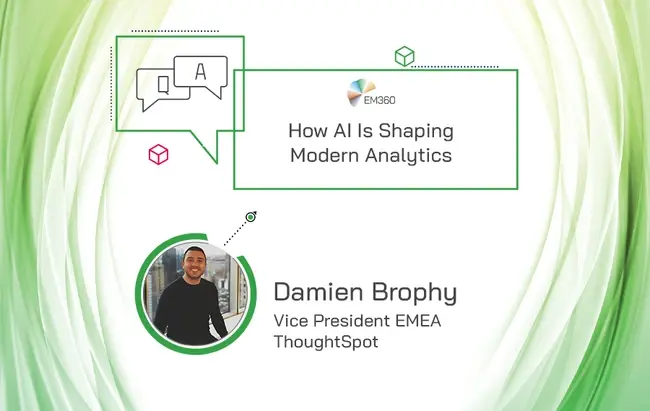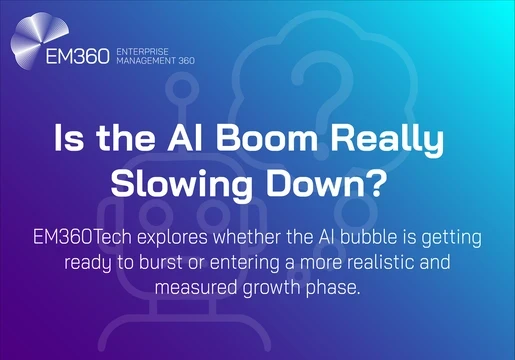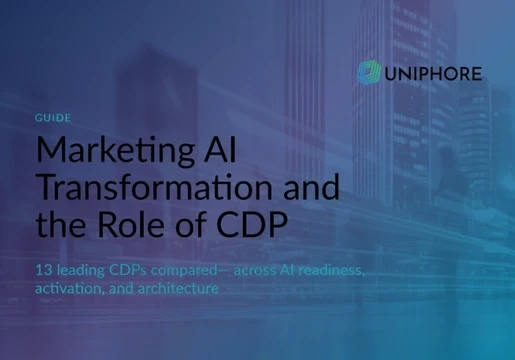Artificial Intelligence (AI) is changing the game in all aspects of the enterprise, and that includes where business analytics is concerned. Fusing together to form AI analytics, the interdisciplinary sector is enabling organisations to automate data analysis - a traditionally time-consuming and mundane task that takes a lot of people power - and enhance their business intelligence with AI and machine learning technologies. Search and AI-driven analytics platform, ThoughtSpot is making huge moves in this industry with their SaaS-based modern analytics cloud solution, ThoughtSpot Cloud. In this Q&A, we sit down with Damien Brophy, the VP of EMEA at ThoughtSpot, about the various ways in which AI is shaping analytics and benefiting companies.

How exactly is AI shaping and being used in analytics? Can you share a ThoughtSpot case study example to elaborate?
This revolution in technology has gone from gathering data to connecting people. The next stage is providing valuable interpretations of that data for networked people. As AI is increasingly considered the new engine of growth in the modern age, different financial sectors for example, like investment banks, retail banks and insurers, have been incorporating it into their systems.
Nationwide uses ThoughtSpot’s search & AI to power a true data-driven decision making culture. Its analysts empower business users to answer their own data questions to make more data-informed decisions, while significantly reducing their reporting bottleneck.
Nationwide have 300 million rows of data, over 400 active users, five use cases, and are seeing sub one-second response times. After rolling out ThoughtSpot for four use cases it saw adoption rise in its most mature deployment - Mortgage Pipeline - by 220 per cent, and is ongoing. During the deployment, ThoughtSpot’s SpotIQ, which uses AI to spot data outliers, helped Nationwide identify and fix bad data. Now in production, SpotIQ recommends personalised insights to business users based on data trends and outliers.
In just one use case, with 200 users, ThoughtSpot replaced 9,000 static emails being sent monthly, turning off old ‘clunky’ BI reports. Nationwide is moving the culture away from static reporting towards a self-service world.
What does it take for an organisation to effectively automate data today?
Even though analysts need to focus on more strategic tasks, they are all too frequently deployed in answering basic questions. Greater self-service capabilities for end-users substantially increases the value of the data-stack and talent, particularly with live data at both the front and back end, but this is not yet a reality for a majority of organisations. As data is updated in a data platform, a live connection is required for analytics to be truly up to date. Self-service analytics ranks as a priority ahead of automation or machine learning for the last three years in a row, according to TDWI Surveys. We’ve found that only approximately under 10 percent of organisations have the full capabilities of a modern data and analytics stack, and most are only just starting their journey along this path.
When decision-makers are empowered with data they are more productive, effective, and innovative. The future of work will be dominated by these workers, empowered and equipped with the right tools, backed by a data fluent culture. Augmented analytics that use machine learning and AI to assist users in their quest for deep insights are shaping this future, empowered by advances in search-based, self-service analytics. Decision-makers will have many job titles because most roles are made easier when questions can be answered in the moment.
The next frontier of business innovation is coming from citizen-led automation of data-driven processes: Connecting data and insights to business processes and automating the mundane. Yet the next phase is not just about automating data pipelines to find insights. Next, will be automating how those insights then feed back into other systems to drive actions, whether those are cloud data platforms or other applications. This is the reverse ETL market that's heating up right now.
Being able to focus on insights and connecting them to operational processes to automate actions is analytic process automation, which drives ROI across both business outcomes (cost savings, top-line growth, and risk reduction), as well as workforce transformation in terms of knowledge worker productivity and upskilling. If an insight can't be used to automatically initiate or trigger an action, the value of data automation hasn't been fully realised
ThoughtSpot launched the first SaaS platform for search and AI-driven analytics. What are the key benefits of this tool and what advice would you give to organisations looking to digitally transform their business intelligence and adopt such technology?
Automation and self-service are the future in many areas of technology, and particularly in data. There is a need for data analysts at whatever level, and data scientists to both gain fast insights and react to changing needs. With routine quests, automated knowledge workers are free to do everything and everything that human creativity allows with data science.
ThoughtSpot Cloud empowers everyone, from enterprise leadership, to data leaders, analysts, product specialists, and developers to create, consume, and operationalise data-driven insights on the fly.
First, business users. They can search and find their own insights, then use those to trigger other actions.
Secondly, analysts or data pros can stop spending their time on an endless queue of requests from the business. This lets them focus on more strategic projects like AI, ML, and data engineering.
Then, product builders. Anyone launching an app today is creating a treasure trove of data. With the Modern Analytics Cloud they're able to build analytics into their apps, which increases user adoption, engagement, and retention too.
If a user knows how to Google, they can use this consumer-grade search and AI technology to use true self-service analytics. Users can get to what matters in seconds, by asking questions, and shape personalised data stories that fit their exact needs. The AI will even offer suggestions to ensure no insights are left unexamined.
Driving real change with data has to start at the top. Without buy-in from executives, using insights as a core part of all processes cannot permeate throughout the business. If leaders cannot be proactive in bolstering this cultural change, or worse, are actively preventing this change from happening, businesses need to ask if these are the right people to be leading the company. Once this has been established, leaders need to think beyond just implementing new technology and towards full company-wide adoption. No matter how powerful the tool, it cannot add value if it isn’t accessible and usable to all. The Modern Analytics Cloud gives business users an intuitive and simple way to find insights, regardless of their prior data experience. The right tools will not require hours of painstaking learning but will instead automate processes, freeing up employees to focus on the human part of their jobs: business success and customer satisfaction.
Drawing on ThoughtSpot’s Ebook, why are analytics dashboards dead?
For over 20 years dashboards were a foundational part of business intelligence, helping share and visualise data across organisations. They used to be a great vehicle for delivering KPIs without data workers needing a background in coding or IT to use them.
But over two decades much changed, including the appetite and needs of business users. In 2020 COVID-19 made painfully clear that dashboards lacked the speed, scale, and granularity to make real-time decisions with data. Pixel-perfect charts became costly, high-maintenance works of static data art instead of useful views into the real-time health and status of the business. Demand for new, unforeseen analytics use-cases skyrocketed and dashboards were sidelined for manual data extracts and daily reports. Day-old data became useless for fast-changing situations demanding in-the-moment insights, pushing analytics teams to breaking points.
86% of frontline workers report a need for better technology to get insights (HBR, 2020), and 67% of executives aren’t comfortable accessing or using data from their existing tools and resources (Deloitte, 2019). Static dashboards are dead. Live cloud data has overthrown the legacy paradigm.
Augmented analytics is just one product of the emergence of AI and analytics. In what ways can companies take advantage of augmented analytics to synthesise new insights?
Primarily, eliminating the ‘curiosity tax’ is a huge advantage of augmented analytics. It allows people to fully bring their human experience and combine it with data-driven insights to create new knowledge. They can then easily use that to drive new and better action.
In the old world, this required asking for someone else's help. In doing so, people refrained from asking unless they already knew the answer would drive something - there was too much of a ‘tax’ on exploring, being curious, and bringing imagination to the data.
Augmented analytics is the future of data and analytics. It will allow more organisations to be successful with analytic operations and will save companies money, speed up decision-making, and offer an overall better ROI from their data professionals.
Augmented analytics is still in its early growth phase, but companies can realise its benefits by leveraging simple, smart, and enterprise-grade capabilities of search and AI-driven analytics.
How do you see AI in the analytics industry growing and advancing over the next three years?
There are two bid areas coming. Firstly, insights will be used to automatically drive actions and workflows in other apps. Secondly, analytics and AI will be infused in every app, the way Stripe has infused payments in most apps today.
This is because AI in analytics is a growth technology. ThoughtSpot reported growing customer traction in the summer. Driven by growing customer adoption, ThoughtSpot EMEA’s ARR grew approximately 50% YoY, while the average deal size grew more than 20% YoY. Organisations are desperate to enhance their analytics capabilities and they see AI as the way forward to managing the scale of cloud data with the available analytics talent in the market. It’s easier to support the people you have in the business and make use of their domain knowledge than to wait for a time when you’ve hired perfect analytical talent from top to bottom.
The industry is only at the beginning of its journey bringing the magic of analytical insights to everyone, and in three years AI analytics technologies may be embedded throughout enterprises with search capabilities in many of the most widely used apps. Knowledge workers will be able to question everything and find better ways of solving their daily challenges.
Sources:
https://www.thoughtspot.com/blog/avoid-another-analyst-fire-drill-with-the-modern-data-and-analytics-stack
https://docs.google.com/document/d/1eWqYGDBt3xm83q9HqlmvfAjWZnCVRdWS4QMvtC9XOqU/edit
https://www.thoughtspot.com/blog/meet-the-analyst-and-data-scientist-of-the-future-from-investec
https://docs.google.com/document/d/1BBWZtXGraV_eX5qtACkxSicW60KJmR4PCBTKgoilWn4/edit
https://www.thoughtspot.com/solutions/is-augmented-analytics-future-data-analytics







Comments ( 0 )